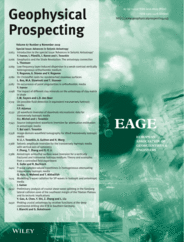-
oa Seismic amplitude inversion for the transversely isotropic media with vertical axis of symmetry
- Source: Geophysical Prospecting, Volume 67, Issue 9 - Advances in Seismic Anisotropy, Oct 2019, p. 2368 - 2385
-
- 24 Feb 2019
- 22 Jun 2019
- 22 Jul 2019
Abstract
Transverse isotropy with a vertical axis of symmetry is a common form of anisotropy in sedimentary basins, and it has a significant influence on the seismic amplitude variation with offset. Although exact solutions and approximations of the PP‐wave reflection coefficient for the transversely isotropic media with vertical axis of symmetry have been explicitly studied, it is difficult to apply these equations to amplitude inversion, because more than three parameters need to be estimated, and such an inverse problem is highly ill‐posed. In this paper, we propose a seismic amplitude inversion method for the transversely isotropic media with a vertical axis of symmetry based on a modified approximation of the reflection coefficient. This new approximation consists of only three model parameters: attribute A, the impedance (vertical phase velocity multiplied by bulk density); attribute B, shear modulus proportional to an anellipticity parameter (Thomsen's parameter ε−δ); and attribute C, the approximate horizontal P‐wave phase velocity, which can be well estimated by using a Bayesian‐framework‐based inversion method. Using numerical tests we show that the derived approximation has similar accuracy to the existing linear approximation and much higher accuracy than isotropic approximations, especially at large angles of incidence and for strong anisotropy. The new inversion method is validated by using both synthetic data and field seismic data. We show that the inverted attributes are robust for shale‐gas reservoir characterization: the shale formation can be discriminated from surrounding formations by using the crossplot of the attributes A and C, and then the gas‐bearing shale can be identified through the combination of the attributes A and B. We then propose a rock‐physics‐based method and a stepwise‐inversion‐based method to estimate the P‐wave anisotropy parameter (Thomsen's parameter ε). The latter is more suitable when subsurface media are strongly heterogeneous. The stepwise inversion produces a stable and accurate Thomsen's parameter ε, which is proved by using both synthetic and field data.




